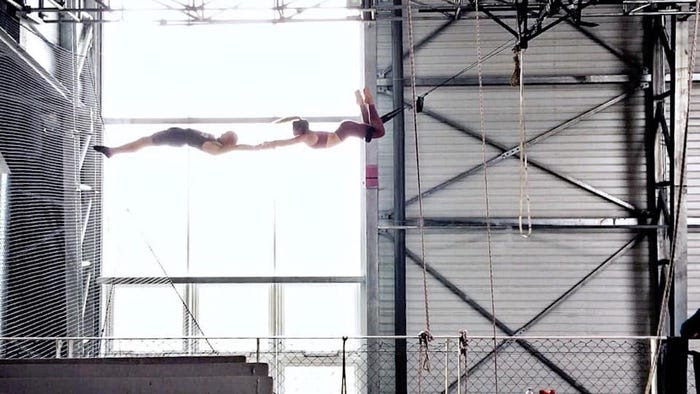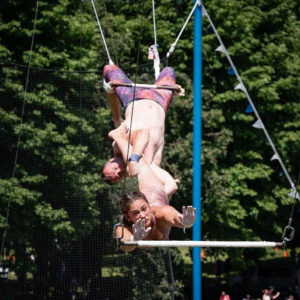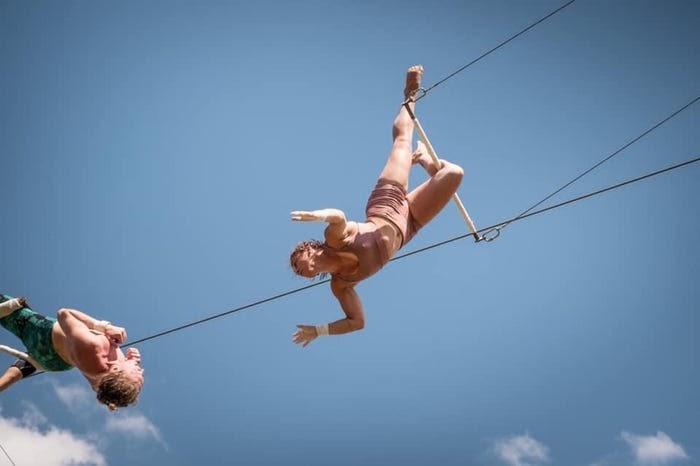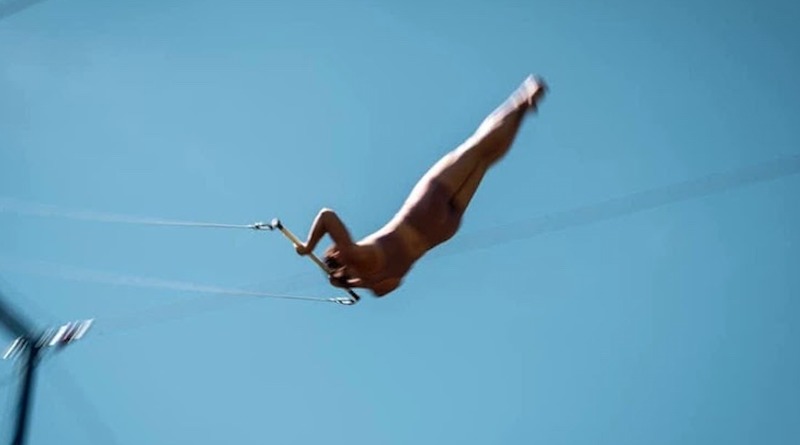I Started Flying Trapeze After I Was Sexually Assaulted. The Sport Has Saved My Life.
Like many people, I like being in control. I’m also very afraid of heights.
I was not a child who thrived on risk — I once cried in gym class when asked to do a forward roll down a plush gymnastics wedge.
I had mapped out a college plan in elementary school. I was that kid.
That’s why people are often surprised to hear that I grew up to become a flying trapeze artist — but I can safely say the sport saved my life.
Flying trapeze was invented by Jules Léotard, a French acrobat credited with debuting the swinging act on November 12, 1859. In 1983 it entered the recreational scene, when trapeze artist Bob Christians pioneered the first flying trapeze program at former Club Med resort Eleuthera. Today there are recreational schools in 36 countries worldwide.
I started flying a year after I was sexually assaulted. At the time, I was living with undiagnosed post-traumatic stress disorder (PTSD).
After my assault, I loathed my body.
I texted my best friend saying: “I want to take a shower with a wire brush and burn off my skin.”
As an athlete, I went from viewing my body as strong and capable to viewing it as weak, desecrated, broken.
I was in graduate school running on cheap espresso and backlogged anxiety. Crying in public had become so routine for me that I had stopped wearing mascara and carried a pair of sunglasses in my purse to hide behind on my daily commute. I was spiraling.
Flying Trapeze Can Have Therapeutic Benefits

There’s a pervasive belief in the trapeze community that flying provides immense therapeutic benefits.
Social circus is now even used in restorative and therapeutic practices worldwide. Programs such as the Oxford-basedHigh Fly Trapeze offer community classes to members of the public recovering from narcotic abuse. Meanwhile,Peter Gold’s “Trapeze Experience” in Las Vegas offers up “Self Discovery Workshops,” week-long programs that promise you will “face and overcome your fears” and “breakthrough mental, emotional, and physical blocks.”
I was familiar with social circus when I took my first flying trapeze class; I had spent the months leading up to my first class working with at-risk youth atJL Circus, a social circus program pioneered by north London performing arts venue Jackson’s Lane.
I knew that much of social circus’ success was attributed toDr. Stephen Porges‘Polyvagal Theory, which hypothesizes that our experiences have a direct effect on the central nervous system, physiological responses, and our consequent behavior.
I had devouredDr. Jessica Ruth Hartley’s work on the psychosomatic benefits of teaching trapeze and controlled risk. I had seen first-hand the transformative benefits that circus had on our students. For others, I was a believer that the circus is a medicine for the soul.
That said, I took my first flying trapeze class not because I sought out the therapeutic benefits, but because my best friend wanted to give it a go for her birthday, and I’d be loathe to send her on her own.
As I Stared Down at the Net, Everything Was Telling Me Not to Jump
With hindsight, I could claim that I did so with a subconscious primal pull to help myself, but the truth is the chaos that was raging daily in my brain had been normalized. I had codified my trauma in an effort to survive. I had been told by counselors that I was doing exceptionally well, so I buried my flashbacks and outbursts alongside my grief and did my best to be a poster child for survival.I arrived on my first flying trapeze class full of trepidation. This seemed like a recipe for disaster. What if I panicked? What if I couldn’t do it? I was afraid before I had even begun.
Fear is an evolutionary response to promote survival. Human beings have evolved to avoid situations that could kill us. Standing on the edge of a board 23 feet in the air preparing to jump is one such situation. You may logically know you are safe, but our ape brains don’t flourish on logic. We are hardwired to believe jumping from a high ledge is deadly, and therefore should be avoided at all costs.
This was my conundrum the first time I attended a flying trapeze class. I knew I was in safe hands — beginner students are securely strapped into safety belts and safety lines, which are manipulated by a skilled lines puller on the ground. I knew that this sport involved risk that was controlled and calculated. But as I stared down at the net below, all my evolutionary wiring up to this point was screaming at me not to jump off the very high platform to certain death.
Every Time I Landed in the Net Safely, I Was Reminded that Other People Could be Trusted

I jumped, didn’t die, and my life changed forever. I was an addict, flying as many times per week as my schedule and body would allow.
My hands often resembled mincemeat. I was drunk off adrenaline and sunshine. For the first time in what felt like a lifetime, I experienced the sweet spring blossom of confidence.
In the span of a month, I went from trembling every time I stood on the platform to quickly becoming accustomed to the height (which wasn’t all that high after all, I would quickly reason). After a month, I took my first swing without safety lines and marveled at how inexplicably quiet flying through the air can be. I had never felt so free.
I had entered the fly world worried that the sport would bring out the ugly in me, shining a spotlight on the anger that often accompanied my perceived loss of control, which my brain had been rewired to believe meant danger, desecration, and risk of death.
But flying did the opposite. At the beginning, I had to trust my bodily safety to three people at any given time — the board worker, the lines puller, and the catcher. I had to trust that their knowledge and expertise would both keep me safe and help me become more self-sufficient. Every time I landed in the net safely, I was reminded that other people could be trusted. Here was a group of people who were working very hard to keep me safe. I didn’t have to do this all on my own.
When I began to graduate to taking tricks “out of lines” — that is, performing tricks without a safety harness — I learned that not only did these people wish to keep me safe, but they also trusted me, my instincts, and my choices. It was revolutionary.
I Never Thought Trapeze Would Become a Career
Eventually, I learned to catch and became a coach and the torch was passed; suddenly others were trusting me with their safety.
I have a multidisciplinary career; I have spent the last decade of my life galavanting around the globe creating theatre, teaching movement, and modeling for artists.
Circus has always been woven into the canvas of my work; my fifth grade teacher was a clown who ultimately set the course of my life by teaching me to juggle fire, and I have spent years twisting myself into pretzels on an aerial hoop.
Until I first found the gall to jump off the platform, flying trapeze never registered as a possible addition to my repertoire. The height, the speed, the seeming lack of full control of it all had automatically been categorized as impossible.
Now, flying has gone from a seemingly impossible one-off experience to a part of my career that I cherish. As acoach, I have begun using fly as a tool to teach animators when I guest lecture atCentral St Martins, and I’m currently working toward my goals of joining the ranks of the few female catchers to be part of a professional fly show.
When I think about the number of students and professionals who have trusted themselves in my hands as a catcher I am floored. I am a petite woman who emerged from a trauma thinking I was broken and weak, but these are people (often larger than myself) saying: “That is nonsense. I trust you. You will keep me safe.”
‘Trapeze is Controlled Chaos’

Dr Jonathan Diamond, a psychotherapist specializing in trauma and addiction in adolescents, createdHilltown Youth’s “Recovery Theatre” to utilize circus and flying trapeze as a rehabilitation tool for adolescent substance use disorder.
He told Insider: “Trauma creates physiological responses in the body. Your body has a long memory. Circus helps you form new neural pathways that help your body catch up with your brain.
“It is a paradox because flying trapeze can simulate a real sense of fear and danger; you’re up high and you’re being asked to do the impossible, but in reality you are very safe on a fly rig. Trapeze is controlled chaos.”
It’s important to note that most trapeze schools are not designed to moonlight as social circus therapies, and that most staff are not trained therapists. Flying shouldn’t replace traditional therapy, but rather a supplement to it.
For victims of trauma, the sense of controlled risk provided by trapeze can be universally transformative.
Recreational student Chris Collins told Insider he was attacked by a group of five teenagers in 2014, resulting in the loss of his right eye.
“I have three titanium plates permanently holding my face together,” he said. He sought therapy, was diagnosed with PTSD, and was put on antidepressants. Then he began flying.
“I am no longer taking any anti-depressants and am so much happier with life,” he said. “I am much more confident in just about everything I do, and am fitter than I have ever been in my life. And this turnaround is totally due to flying.”
Diamond told Insider that the benefit comes from expanding your horizons, but in a safe way.
“When we are dealing with trapeze and trauma, the learning curve needs to be different enough that [the student] is out of their comfort zone but not so much that it is traumatic,” he said.
This notion of finding comfort in discomfort resonates with the community.
“I have PTSD,” one professional flyer, who chose to remain anonymous, told Insider. “When I’m flying I am risking my life; I have to have my mind in the right place and can’t be thinking of anything else to stay safe. I think it has been a great escape for me.”
‘You Don’t Want to Conquer Your Fear; You Want to Become a Student of It’

Philosopher-turned-trapeze-artist Sam Keen is the founder ofTrapezePro, a recreational flying trapeze school in Sonoma, California, and pioneer of“Upward Bound,” a flying trapeze program aimed at empowering abused women and rehabilitating “troubled youths.”
Keen equates flying to a release of control, and insists that for trapeze to be effective, one must learn to honor trust and let go — literally.
“We must become connoisseurs of fear,” Keen told Insider. “At the flying trapeze school we work to distinguish between what is panic and what is fear. Panic doesn’t serve you. Flying trapeze allows you to deal with fear in a safe situation, and those experiences will transfer over to daily life.
“Students come to my fly rig and say that they want to conquer their fears and I tell them that isn’t the point. You don’t want to conquer your fear; you want to become a student of it. See what it makes you do and learn from it.”
When I began flying I was not so much a connoisseur of fear as I was a prisoner of it. But through trapeze, my fear of heights became the only fear I felt I could actively control. Flying trapeze offered up a seemingly impossible and dangerous task (jumping off a 23-foot-high platform) and an instant reward (landing in the net safely and proving my fear of jumping and dying was unfounded). It taught me that my fear did not have to control my narrative. Many days, flying was the only thing that made me feel safe.
Flying Gave Me the Confidence to Finally Stick with Therapy for Good
There is a moment of stasis just before you jump off the platform where your mind must calibrate with your body. You must push away all doubt, all outside worries, and focus in on the goal at hand. Injuries happen when your mind and body are out of sync, when the little voice in your head plants a seed of doubt. I have gone from fearing the height that flying demands to respecting it. I know that I have the skills and foundations to keep myself safe, but I also know that it could kill me. Much like life, it is a balancing act.
The times I have been injured flying trapeze have been because my anxiety or my ego have pushed me out of tune. Some of those times were frustrating, like when I broke my big toe on the platform during a warm upswing. Some of them were illuminating; I got tipped on a return and plummeted headfirst to the net. I was able to twist to my back, but gave myself a black eye in the process.
I might have been the happiest person to ever have a black eye. I rolled out of the net relatively unscathed with the realization that I was very capable of saving myself if things went wrong. Even in crisis, I could reclaim my control. I posted a selfie to Facebook, positively beaming.
Flying gave me the confidence to finally stick with therapy for good in 2018, when I was formally diagnosed with PTSD. I’m not sure if I would have had the gumption without the sport and the community. There is a very real chance that if I had never had the courage to jump, I would not be alive to write this today.
Flying trapeze saved my life. I found a career, a global family, love, hope.
Due to the COVID-19 pandemic, my entire industry has come to a standstill. We have stayed land-bound in a radical act of love.
For many of us, this has meant sacrificing our own mental health, but I do not feel alone in saying that we are blessed beyond measure to have a job and a sport that feels painful to abstain from.
As we hold our collective breath and wait for the end of this pandemic, I can only hope that when it is safe to fly again we will welcome those in need of escape, healing, and controlled chaos with open arms.
All photos provided courtesy of Morgan Barbour. Feature photo Morgan Barbour flying trapeze in Oxford, UK.Andrew Walmsley.This article was orginally published on Insider
...Do you have a story to share? Submit your news story, article or press release.





